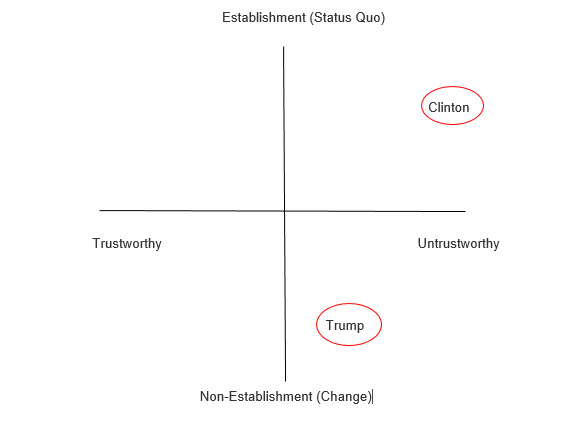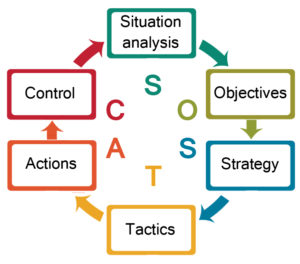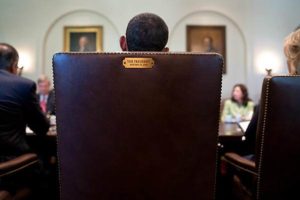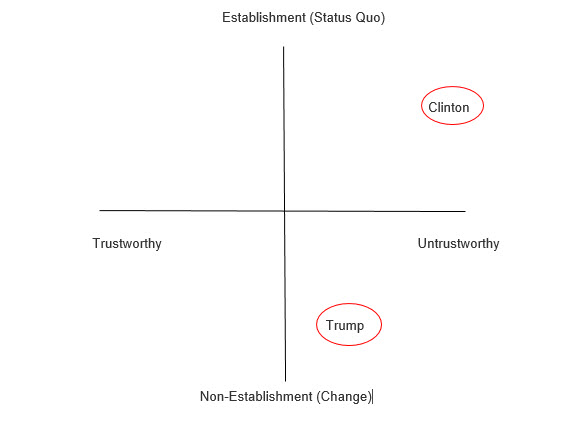
Many are still wondering how Donald Trump became president of the United States of America, despite himself? Here's an analysis, using SOSTAC® Planning Framework to explore some of Trump's plan and to give some insights into his subsequent successful campaign. Comments are most welcome. Situation analysis (where are you now) , Objectives (where are you going?), Strategy (how do you get there?), Tactics (the details of strategy), Action (how do you ensure excellent execution) and Control (how do you know you are getting there - what will you measure?). I will use these to categorise various aspect of the Trump campaign but please remember this is just an outline not an in-dept detailed analysis.

PR Smith's SOSTAC® Planning Framework
Situation Analysis
Customer Analysis
Who - are Trump's potential voters?
Trump focused on "left-behind" voters, specifically white working-class men (and women). He initially gambled on targeting one powerful voting bloc, (some pollsters thought this would alienate too many people) suggests Harvard's professor Stephen Greyse (Fottrell 2016). Clinton's target audience was far broader, reaching out to the middle-class and "left-out" voters and black and Latino 'left-out' voters (many of whom had not yet a slice of the American pie). A month before the elections Trump had 57k transactors (contributors) of whom 68% were male and 32% were female, compared to Clinton who had 914k transactors of whom 36% were male and 64% were female. Far more variables were eventually used to segment the market into dozens of target segments. In fact, a small English company who had also worked on the Brexit 'Leave' campaign for UKIP, worked for Trump and divided the US population into 32 personality types, and focused on just 17 states (see part 3).
Why - do Trump's potential voters vote (what are their needs)?
Many people wanted change. Many others were frustrated and maybe even angry about their lives. Some have fears rather than hope. Is it possible that Trump's upbeat' #MakeAmericaGreatAgain or #MAGA hashtag played into the unconscious fears that if you don't vote for Trump, America will get worse ie whatever is bad about America will become far worse? See the word-cloud graphics (in the final, 'Control' section) which demonstrates how Trump repeated these messages.
What the elite missed was the sources of the anger & resentment that has lead to the populist upheavals in the US & Britain & many other parts of the world (Harvard's Professor Michael Sandel 2017).
Why were voters angry?
What the elite missed was the sources of the anger & resentment that has lead to the populist upheavals in the US & Britain & many other parts of the world. (They) assumed it's anger against immigration and trade and at the heart of that is jobs. But it's also about even bigger things., about the loss of community, disempowerment, & social esteem (a sense that the work that ordinary people do is no longer honoured & recognised (& rewarded).' Sandel 2017)
How - do Trump's potential voters decide (how do they process information)?
Shorter attention spans. Research from Harvard revealed that attention spans for the first ever telivised political debate between JFK and Nixon back in 1960, was only 42 seconds (the maximum time to get a serious political message across). This fell to just 5 seconds in 2008 and even less since in 2012. There are many other variables involved here also, but, short attention spans is significant and perhaps gives a clue why Britain voted marginally for Brexit (short anti-EU messages had far more impact than long economic pro EU messages).
Major Market Trend - A Gap In The Market
We live in a post truth-era. 'Dishonesty in politics is nothing new; but the manner in which some politicians now lie, and the havoc they may wreak by doing so, are worrying' says the Economist magazine (2016). The worrying phrase 'post-truth' was even named Word Of The Year by Oxford Dictionaries (Flood 2016). Defined by the dictionary as an adjective "relating to or denoting circumstances in which objective facts are less influential in shaping public opinion than appeals to emotion and personal belief". The spike in usage, it said, is "in the context of the EU referendum in the United Kingdom and the presidential election in the United States".
This is compounded by the moral vacuum which opens the gates for extremist politicians. Here is Harvard Professor Michael Sandel's chilling observation: "... in the face of pluralism and for the sake of toleration ... to insist on a non-judgemental, value-free politics .. that creates a moral vacuum , a void, that will invariably will be filled by narrow, intolerant moralisms." Sandel (2017)
Competitor Analysis
During the Republican nomination race, Trump saw a right wing gap and went for it. He also analysed the political establishment through the eyes of disenchanted voters. Trump became the Republican candidate for the presidential election. Next he analysed his opposition, the Democrats, Hilary Clinton. When he found a perceived weakness that resonated with his voters (see the Control section in part 2) he went for it. President Obama had unprecedented success in targeting, organizing and motivating voters,we imagine Trump's team studied this blog post How Obama Became America's First Black President to understand his competitor's strategy and tactics.

This photo of Obama's Chair from behind, in the Oval office, This image went viral during the 2008 campaign with the caption: 'This seat is taken'
This image went viral during the 2008 campaign with the caption: 'This seat is taken'
Current Performance
With the election just a month away, donations raised by October 2016: Clinton had $298m from 914,000 transactors (donors) and Trump had just $50.1m from 57,000 donors (Cortana et al).
Opinion polls favoured Clinton.
Objectives
Originally to win the Republican Nomination and then, win the presidential election (after that we just don't know).
Strategy
Old Strategy
Trump initially raised his own profile by making headline-grabbing statements, often by calling in to television shows, supplemented by a rally once or twice a week to provide the appearance of a traditional campaign (Bertoni 2016).
New Strategy
Trump's crystal clear positioning as the 'controversial (non-establishment) ordinary guy' was supported by data driven highly targeted tailored messages on facebook & twitter to "left-behind" white working-class men (and women), combined with sentiment manipulation, machine learning, constant beta culture and almost instant reactions to audience mood swings.
Trump's son in law, Jared Kushner, took over the campaign created this new strategy and, amongst other things, set up a secret data operation-like a Silicon Valley startup. 'Kushner eventually tipped the states that swung the election. And he did so in manner that will change the way future elections will be won and lost.' (Bertoni 2016).
Positioning
Trump positioned himself as a non-establishment guy. An 'outsider' - a 'non-political establishment guy'. He simultaneously positioned Clinton as an establishment person. An 'insider' (a politician linked to Obama's policies) (Kanski 2016). Trump played the confrontational card which helped him to establish authenticity amongst frustrated voters. So he became a 'controversial (non-establishment) ordinary guy'.
Meanwhile, Trump positioned Clinton as an untrustworthy 'insider' and threatened to take her to court after the election. Clinton's authenticity was challenged by high-lighting the fact that 'she seemed to say one thing in her speeches and another behind the scenes, illustrated in her emails leaked by Wikileaks and "basket of deplorables" comments (Kanski 2016). The CIA revelations days before the vote appeared to attack Clinton's authenticity. Or was all this information fed by the Russians? There's definitely a movie in this story.
'controversial (non-establishment) ordinary guy' v untrustworthy 'insider' establishment lady
Was it like this?

A possible perceptual map showing trump positioned as a non-establishment reasonably trustworthy guy and Clinton as an establishment lady and untrustworthy.
Apart from Clinton's followers, one wonders whether the average American could relate to Clinton as easily as they could to Trump (or Obama in the previous two elections).
The 'Ordinary (non-establishment) Guy' Created Authenticity
While Trump followers believed Trump had authenticity as he, rightly or wrongly, 'says it like it is'. The difference in authenticity, according to Kanski, was simply that 'People can relate to bankruptcies, to locker room talk, to tough talk on terrorism, and that was difference. Whilst Trump might be a billionaire, but he's been bankrupt, uses locker-room talk i.e. his life experiences somehow seemed to resonate more with the average undecided voter.'
Targeting
Trump stayed focused on the "left-behind" voters, specifically white working-class men (and women). As mentioned earlier, this was deemed risky (targeting one powerful voting bloc). Clinton's target audience, on the other hand, was far broader, reaching out to the middle-class and black and Latino 'left-out' voters (many of whom had not yet a slice of the American pie). Trump's relentless use of data continually sharpened his targeting of those battleground states (the 'swing states', that over recent elections have gone both ways). They are the key to winning the election. In recent elections Florida and Ohio (3rd and 7th largest states, with 29 and 18 electoral votes respectively) have been swinging back and forth between the parties.
Data-driven Decision Making
Within three weeks, in a nondescript building outside San Antonio, Kushner had built what would become a 100-person data hub designed to make more informed decisions which leveraged the magic marketing formula (see part 2):
- messages (topics of speeches)
- targeting
- travelling / rally locations
- fundraising
Kushner built a custom geo-location tool that plotted the location density of about 20 voter types over a live Google Maps interface.
This blog originally appeared here: http://prsmith.org/2017/01/20/how-trump-won-a-sostac-analysis/. This is Part one of how Trump won, part two covers Tactics, Action and Control. Read How Trump Won Part two now.
Did you find this blog useful?
At the IDM we are passionate about educating marketers and providing resources to help advance your career.
If you are interested in enhancing your CV and upskilling, browse through our wider range of marketing courses and qualifications; from one-day short courses to post-graduate diplomas.
Our learning and development team will be happy to advise based on your needs and requirements.
